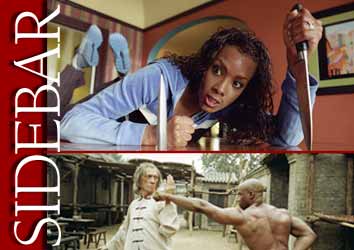
KILL BILL • page 2 • page 3 • sidebar MOVE in MOVIE • page 2 • page 3 DVD • page 2 • page 3 |

 |

| Robert
Richardson, ASC on Camera Movement |
Sidebar |
|
American Cinematographer: What films and filmmakers have most influenced your sense of camera movement? Robert Richardson, ASC: At this moment in my career, I'm most influenced by Hitchcock's films, primarily because of their precision. It's difficult not to cite Kubrick, of course; the Steadicam work in The Shining is amazing, whether it's following behind the boy in the hotel corridors or leading Jack Nicholson through the maze at the end. Martin Scorsese's films are also a huge influence on me. The camerawork in Raging Bull, especially during Jake LaMotta's final bout with Sugar Ray Leonard, is phenomenal; it's whirling around and around, but the framing stays very precise. Bernardo Bertolucci is a master of motion. Along with Scorsese's, his work is one of the biggest influences on my career. In The Last Emperor, there's a shot where the sounds from the outside world are coming to Pu Yi from over the huge wall of the Forbidden City; the camera cranes up from to the edge of the wall to "hear" them, and then comes back down. The difficulty of creating those moves and lighting them, which Bertolucci achieved in collaboration with [Vittorio] Storaro [ASC, AIC], are accomplished to an extraordinary degree. I don't know if they've ever been equaled. The films you've mentioned often feature very overt or elaborate moves. Do you find that kind of camerawork particularly inspiring? Richardson: Well, even with the more elaborate ones, it's not so much about 'punching home' a scene through camera motion as it is about being appropriate. Andrei Tarkovsky, for example, is not one to 'punch' anything in his films, but they have incredible visual impact because the camera movement is always extremely appropriate in emphasizing certain psychological moments. My Name Is Ivan has some phenomenal camera motion, with the frame moving in a very deliberate way between the trees [in a flooded forest at night]. I'd call it poetry in motion, and it's remarkable in its artistry. All the filmmakers I've mentioned have very different visual attitudes, but they are all very deliberate about where and why they move the camera. Has your own sense of how to move the camera changed over the past 20 years? Richardson: It has evolved through age, experience and knowledge. The choices I make now are less bound to a sort of 'from the hip' sensibility. I still have the capacity for that kind of work, obviously; Natural Born Killers was not that many years ago. I have no problem with randomness or improvisation, but now I'm much more aware of making those choices - and what they mean - than I was at the earlier stages of my career. Sidebar
|
||

